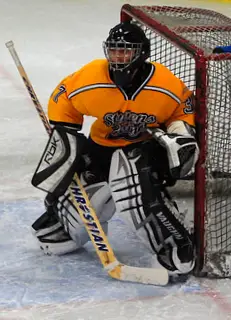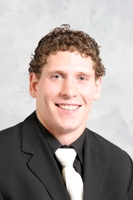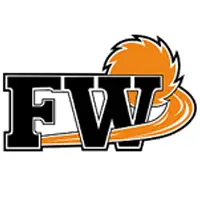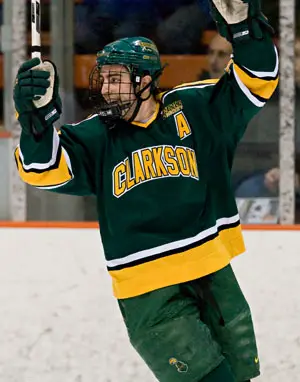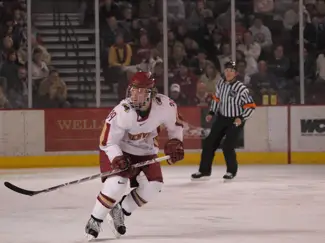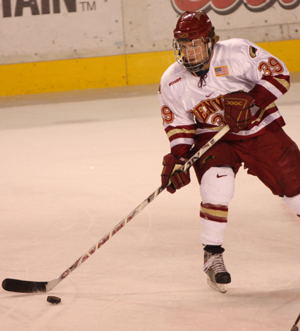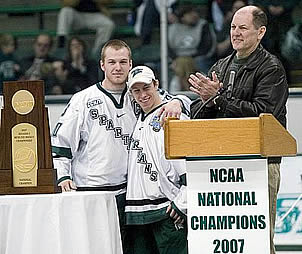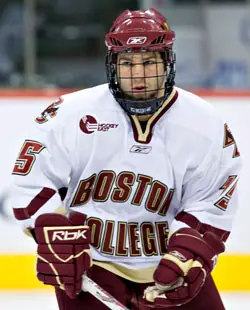First
Congratulations to Lake Superior State. With an uncharacteristic offensive output, the Lakers beat the visiting Bowling Green Falcons, 4-1, Saturday night, to claim their first CCHA victory of the season.
Saturday night’s hero was Simon Gysbers, a sophomore defenseman who had the offensive game of his life. Gysbers had a goal and three assists in the win after entering the game with two goals and four helpers in 19 games prior to the win. In 41 games last season, Gysbers had four goals and nine assists.
Add Gysbers to the list of CCHA players who like winning. “It feels good to win again,” said the blueliner after the victory.
Gysbers was also credited with blocking five shots in the two games against BGSU.
Gysbers, a 20-year-old native of Richmond Hill, Ont., is on something of a hot-ish streak of late for a team that needs all the offensive help it can get. In their last three CCHA series dating back to Dec. 7, the Lakers are 1-2-3, their best run of the season. Gysbers had goals in the win over Bowling Green and in the 3-3 tie against Nebraska-Omaha (Dec. 8), and an assist in LSSU’s 3-3 tie against Michigan State in Munn Arena (Jan. 5).
That gives Gysbers six points in LSSU’s last six games.
Ten, Eleven and Twelve
Three teams remain mired at the bottom of the CCHA standings, each with league points in the single digits.
On the surface, No. 10 Ohio State (7-15-2, 3-10-1 CCHA), No. 11 Lake Superior (3-13-4, 1-10-3 CCHA) and No. 12 Western Michigan (6-15-1, 2-12-0 CCHA) have nothing in common.
The Buckeyes, who play in the gazillion-dollar Schottenstein Center, were picked fifth by both the coaches and the media in the league’s preseason polls. The Lakers, whose remote location and limited budget gives them tangible disadvantages, were picked seventh by the coaches and ninth by the media. The Broncos, who in November of this season extended head coach Jim Culhane’s contract through the end of May in 2011, were picked 10th by the coaches and seventh by the media.
Each team is faring more poorly than expected, and it’s difficult to define each squad’s failure to thrive. Fans have been writing me to blame coaching for OSU’s and WMU’s seasons, and it’s easy to finger the loss of Jeff Jakaitis in Sault Ste. Marie for LSSU’s rough first half.
So while the big-city Buckeyes languish in a lavish building, the remote Lakers grind away in the Yoop and the Broncos continue to get pounded by the CCHA opposition both home and away, the common factor is a complete and total inability to sustain anything resembling an offense this season.
In other words, you just can’t win if you’re not scoring goals.
OSU and WMU both have 28 CCHA goals to their credit, while LSSU has 29. And while the Broncos and Lakers are outscored by bigger margins than are the Buckeyes, each team has one of the lowest-scoring offenses in the nation.
There is absolutely no reason for Ohio State to have the 41st-best — or 19th-worst — offense in the nation. The team may be young, but so is Michigan; with nearly as many freshmen on the roster as has OSU, the Wolverines have the second-best offense in the country. Anyone who has seen Value City Arena has seen the money behind the OSU program, money that at other schools — UM, MSU and Miami, for example — has brought significant and consistent results.
And the Buckeyes have the long athletic tradition that should translate into powerhouse hockey, a tradition that Jeff Jackson is taking full advantage of at Notre Dame.
Even watching Ohio State all season, I still do not know why the Buckeyes have just three CCHA wins.
The Broncos are a semi-enigma. WMU doesn’t have the Big Ten behind it, but Lawson Arena is a rockin’ little venue — with a true collegiate atmosphere and insanely loyal fans — and the school’s location and size make it very attractive to certain types of players.
It doesn’t make sense that Western was the sum of two players last season, freshman Mark Letestu and senior Paul Szczechura. With their departures, WMU lost 43 goals.
But whither Jeff Pierce and Brian Bicek? Pierce had 12 goals last season and Bicek 15; each has three this year.
And what of Jeff LoVecchio, a fantastic two-way hockey player? LoVecchio should be a CCHA stud, a household name and stats leader this season after his 19-goal output of a year ago (19-15–34) and his genuine talent. Instead, his seven goals and six assists put him second behind Patrick Galivan (7-15–22) among Bronco scorers.
And what of the Bronco goaltending? Last year, Riley Gill’s .912 save percentage was good enough to usurp Daniel Bellissimo and earn Gill a spot on the CCHA All-Rookie team.
This year, it’s freshman Jerry Kuhn who has the .912 SV% while Gill has allowed 3.44 goals per game with a .892 SV% in 17 contests.
As for the Lakers, it’s easy to say that Jeff Jakaitis held that team together last season, so let’s say it. Jakaitis had a career year that helped to raise the level of play of everyone else on that squad. And just as Michigan State had to adjust to the departure of Ryan Miller — around whom the Spartans were built — so does Lake Superior State need to adjust to life post-Jakaitis.
But the Lakers will, and will undoubtedly perform to the best of their program’s ability in the years to come. That may not be enough for Laker fans, however, who remember the glory days from the late 1980s through the end of the Jeff Jackson era, but those are the same fans who forget that too much at the university and in college hockey has changed since then ever to return.
Number 9. Number 9.
The number 9 is a fascinating creature. The sum of the digits of every number divisible by 9 equals 9. In Chinese culture, 9 is considered masculine (yang) and is associated with the dragon, the luckiest of all Chinese astrological symbols.
In Hindu, the number 9 is associated with the festival of Navratri, the nine (nava) nights when the nine forms of Shakti, the sacred female force, is worshipped.
The sum of its parts. Male and female divinity. Dragons. Sounds like 9 is the complete player.
In the CCHA, there are 10 guys wearing No. 9, and two of them had performances worth mentioning last weekend.
In Michigan State’s quest to prove itself against Notre Dame, the Spartans took three really important points and No. 9 Justin Abdelkader had the game-winning goal at 18:03 in the third period when MSU beat ND, 3-1, in East Lansing, and he had the first assist on the Spartans’ power-play goal in Sunday’s 1-1 tie in South Bend.
Ferris State’s Brendan Connolly had an unassisted shorthanded goal to get the Bulldogs on the board in FSU’s 2-2 Saturday tie with visiting Alaska. Connolly also had a goal in FSU’s 4-2 loss to Alaska Friday.
For the record, only two teams in the CCHA are currently without a No. 9: Bowling Green and Northern Michigan. And every No. 9 on every team’s roster is an impact player, in some way.
Eight Is Enough
The top eight teams should make it to the CCHA playoffs. Period.
Enough Is Enough
There’s no more hollow an award in college hockey than the CCHA’s Perani Cup.
This week, the CCHA press release contains a note about the “Perani Cup standings.” Of the top 11 vote-getters in this year’s Perani Cup race, eight are forwards.
The very phrase Perani Cup standings implies that there is a genuine competition here. For there to be real competition, the same rules should apply to each eligible player. In the race for the CCHA Perani Cup, the track is decidedly warped.
The Perani Cup winners are chosen based on the “three stars” of each league game at each CCHA arena. The problem is not with the performance of the players, but rather with the selection of each game’s “stars,” which varies widely from venue to venue. Not only is there an inconsistent number of press to participate in each arena, but I have been present at games where no one from the press has been polled to select the stars, or where an SID and I have selected the stars ourselves.
In other words, the Perani Cup is suspect because it can be completely manipulated by the sports information staffs of the teams themselves. It’s very easy to stack the Perani Cup deck.
I do want to say that all members of the press in attendance at Ohio State home games are asked to vote in the Perani Cup, and there are often a number of writers and broadcast media folks, providing a variety of opinion. However, given the widespread inconsistencies for voting for this award, I have not participated in Perani Cup voting this season.
Seventh Place
Two teams are tied for seventh place this week in the CCHA standings, a critical position to examine when the middle four teams host the first round of league playoffs just two months from now. Everyone is buzzing about the Michigan-Notre Dame series, but these two sets are also of vital importance to CCHA play this weekend.
Northern Michigan (9-14-1, 6-10-0 CCHA) at Ferris State (9-9-2, 6-7-1 CCHA)
What a weekend for both the Wildcats and the Bulldogs.
Northern Michigan, which was 7-0-0 all-time against Wayne State going into last week’s home series, lost twice to the Warriors in the Berry Events Center, 4-1 and 3-2. In Saturday’s overtime loss, the Wildcats held a two-goal lead after one period, and gave up the winning goal 59 seconds into OT on the WSU power play.
“We have to play better hockey.” That’s what NMU head coach Walt Kyle said after Friday’s loss, but it’s metaphoric for Northern’s entire season. It’s not that the Wildcats have to play far better hockey; six of NMU’s 14 losses have been by one goal, three by two.
The Wildcats began their CCHA season with a six-game losing streak against the league’s top three teams — Michigan, Michigan State and Miami — but have taken points from teams they should have beaten, such as Bowling Green, Alaska, Lake Superior. The ‘Cats even split with Notre Dame two weeks ago.
In short, Northern is playing like a middle-of-the-pack team, which is what makes this series so interesting and so critical. In ninth place with 12 points and just one point separating the Wildcats from the Bulldogs, NMU also has two fewer games at its disposal with which to gain league points, having played 16 to FSU’s 12.
Last weekend, Ferris State earned one point at home against visiting Alaska; the Bulldogs are now tied for seventh place in the CCHA standings with Alaska, over which they have two games in hand. FSU dropped Friday’s game, 4-3, and tied 2-2 Saturday. In talking to my esteemed colleague at the News-Miner, Danny Martin, FSU head coach Bob Daniels said that the Bulldogs couldn’t solve Alaska goaltender Wylie Rogers enough times to win Friday, and he called Saturday’s tie a “just result.”
The Bulldogs are 3-1-1 in their last five, and 3-3-1 in their last seven games going back to Dec. 7. In their last four league games, however, FSU is 0-3-1. The ‘Dogs swept the Broncos (Nov. 30-Dec. 1) for their last league wins.
FSU hasn’t lost more than two games in a row this season; the Bulldogs split with Notre Dame and were swept by MSU in the first half of the campaign.
Here’s a look at this series by the numbers:
• Goals per game: NMU 2.29 (11th CCHA/47th nationally); FSU 2.70(7th CCHA/t32nd nationally)
• Goals allowed per game: NMU 2.83 (t7th/t36th); FSU 2.20 (4th/t9th)
• Power play: NMU 14.0 percent (11th/39th); FSU 11.9 (12th/50th)
• Penalty kill: NMU 73.6 percent (11th/56th); FSU 84.1 (5th/31st)
• Top scorer: NMU Nick Sirota (12-10–22); FSU Cody Chupp (4-11–15)
• Top ‘tender: NMU Brian Stewart (.893 SV%, 2.94 GAA), Reid Ellingson (.893 SV%, 2.96 GAA); FSU Mitch O’Keefe (.937 SV%, 1.75 GAA), Pat Nagle (.907SV%, 2.40 GAA)
While Cody Chupp is the leading overall scorer for the Bulldogs, Brendan Connolly (7-7–14) is FSU’s leading goal-scorer.
Two more notes of interest. First is that NMU is playing better on the road than at home. Away, the Wildcats are .500 (5-5-0) with a 3-5-2 home record.
The second note is regarding Ferris State’s tendency to take penalties — a bunch of them. The Bulldogs are fourth in the nation in penalty minutes, averaging 18.9 per game. Their PK isn’t that great, but neither is the Wildcat power play. The ‘Cats, however, have returned these past two seasons to a very physical style of play, the old hardest-working-team-in-college-hockey brand of physical that can change a game.
Should be interesting.
Nebraska-Omaha (9-12-3, 6-9-3 CCHA) at Alaska (5-11-4, 5-8-3 CCHA)
There are many things about Nebraska-Omaha head coach Mike Kemp that can be called “wonderful.” Kemp is a good coach and a class act, but best of all is his way with words.
Quoted in the Omaha World-Herald after the Mavericks dropped two home games to visiting No. 2 Miami, Kemp said, “Really, all you can say is good job to Miami.”
In the two losses, UNO was outscored 10-4. In Friday’s 6-3 contest, the Mavericks had overcome a two-goal deficit after one to tie the game at the 16:09 mark in the second on Mick Lawrence’s second goal of the period, but the RedHawks led 3-2 when Charley Fetzer answered less than a minute later.
Early in the third, Matt Ambroz scored to even it up for UNO again, but the Mavericks allowed a power-play tally, an even-strength goal and an empty-netter in the last six minutes of play to give Miami that 6-3 win, a result that Kemp called a “bitter disappointment.”
The third period is something of a liability for the Mavericks this season. UNO gave up three third-period goals to Princeton in a 5-3 loss to Princeton in Omaha Dec. 30; three goals to Yale (all to Broc Little) in a 6-3 loss to Yale in Omaha Dec. 28; three third-period goals in each loss to Notre Dame in November (Nov. 30 and Dec. 1); and two third-period goals to Alaska in a 4-4 tie Nov. 24, three unanswered goals total in that contest, as the Mavs led 4-1 midway through the second.
Then there were the five third-period goals against Michigan Nov. 2, when the Mavericks were up on the Wolverines 2-1 going into the third. And four unanswered goals between the second and third periods against Miami Oct. 27, a 5-2 loss in which the Mavericks once led. And three third-period goals against Miami the night before as well.
The problem is twofold: The Mavericks have a hard time playing with a lead, and they can’t seem to bag the cliched 60 minutes of hockey.
I suggest yoga.
There are two little points separating fifth-place UNO from seventh-place Alaska, and the Nanooks have two games in hand over the Mavericks, making these contests doubly important.
UA returns to Fairbanks after a nice trip to the Lower 48, having split with Ohio State (Jan. 4-5) in Columbus and taken three points from Ferris State last weekend to give UA a 2-1-1 record in the new year and a 2-2-2 record in its last six games, dating back to a loss and tie with Anchorage Dec. 28-29.
Like Northern Michigan, Alaska started with a really unfortunate CCHA schedule, facing Michigan and Michigan State immediately with some funky downtime in the early going. Now all warmed up, the Nanooks haven’t dropped more than two in a row since their five consecutive losses in early league play.
Landon Novotney had two first-period goals in last weekend’s 4-3 win, a game in which most of the scoring occurred in the first, as UA led 3-2 after one. The Nanooks overcame a two-goal Bulldog lead in Saturday’s 2-2 tie, with Dustin Molle scoring in the second and Dion Knelsen in the third.
Senior goaltender Wylie Rogers stopped 82 of FSU’s 87 shots for a .943 save percentage in the two games.
Here is this series by the numbers:
• Goals per game: UNO 3.12 (5th CCHA/17th nationally); UA 2.35 9th CCHA/44th nationally)
• Goals allowed per game: UNO 3.58 (11th/55th); UA 3.00 (t7th/t36th)
• Power play: UNO 24.6 percent (1st/3rd); UA 16.2 (6th/23rd)
• Penalty kill: UNO 84.6 percent (4th/29th); UA 80.2 (10th/50th)
• Top scorer: UNO Bryan Marshall (9-25–34); UA Dion Knelsen (8-13–21)
• Top ‘tender: UNO Jerad Kaufmann (.882 SV%, 2.94 GAA); UA Wylie Rogers (.919 SV%, 2.59 GAA)
While Bryan Marshall leads all Mavericks in points, Mick Lawrence (15-6–21) is the team’s goal leader. And with his two goals against FSU last weekend, Nanook Landon Novotney (8-4–12) is now tied with Knelsen in goal production.
Like NMU, UNO is another team that plays better on the road; the Mavericks are 5-5-0 when travelling this season.
The Mavericks have fast, talented forwards who can chew up the big ice in Fairbanks, but the Nanooks are also fast — and big — and they have better and more consistent goaltending. Should be a telling series.
Speaking of Penalties
Has anyone else noticed how the CCHA has distinguished itself among the top penalty-earning teams in the nation? Leading the nation is North Dakota, but Miami (19.0 PIM/G), Nebraska-Omaha (18.9) and Ferris State (18.9) are second, third, and fourth, respectively. Then we have Michigan (6th/17.6 PIM/G) and Bowling Green (10th/16.7 PIM/G) also in the top 10.
That’s impressive. I hope it translates into a passionate, physical brand of play that knocks the wind out of nonconference opponents (except for NoDak, obviously) rather than a chippy, dirty kind of play that cheapens the league.
I will say that I do like Miami’s, UNO’s and FSU’s brand of physical, having seen them play in person this season.
Six Leagues of Separation
On Tuesday afternoon, I had the pleasure of chatting with two of my USCHO colleagues — AHA Correspondent and D-III guru, Chris Lerch, and CHA Correspondent Matt Mackinder — as well as Elliot Olshansky through the magic of the CSTV.com weekly chat. It was fun although far too short and limited in scope.
We did get to field a few reader questions, but too few. The first one to me was about whether the CCHA is overrated this year, something that must have come from one of the dozens of charming WCHA fans from whom I now receive fairly regular “fan” mail, an unexpected — and certainly entertaining — byproduct of the CCHA’s seeming relative strength this season.
With the PairWise up and running this week, the question of the CCHA’s standing relative to other leagues is both easier and more difficult to answer. Colorado College and Michigan tie for the top PWR spot this week, with Denver third, Miami and New Hampshire tied for fourth and North Dakota rounding out the top six.
No one should be surprised that these are the top six teams in the country. Sure, some people doubted Michigan’s season with so many rookies and Billy Sauer’s first two seasons in goal, but as I’ve said for years, no one should underestimate the House that Red Built.
Northeastern (seventh), Massachusetts (tied for eighth with Michigan State), Mass.-Lowell (10th) and Notre Dame make up the rest of the top 11 teams in this week’s PWR.
Four of the top 11 are CCHA squads, and the top 10 includes three from the CCHA, three from the WCHA, and four from Hockey East. Those top CCHA and WCHA teams have become perennial powerhouses, so why would anyone from anywhere ask if the CCHA is overrated?
All the PWR shows is that the dominance of the three leagues that have dominated for years continues — even with three interesting new comers from Hockey East, which certainly says something about the power of that league.
In Tuesday’s chat, Matt Mackinder was complaining a little bit about how many in college hockey see the AHA and CHA as “the other two” leagues. (Perhaps if we’d had Brian Sullivan on as well, he’d argue that the ECAC is an afterthought far too often, also.) The fact remains that teams in the AHA and CHA have yet to consistently compete with teams in more established leagues, mainly because they’re fairly new. It takes time to build winning programs. You need history, reputation and resources that many AHA and CHA teams lack.
In fact, you need history, reputation and resources that many teams in the CCHA lack, a category in which many coaches in the CCHA (and undoubtedly in the other, more “established” leagues) have much in common with many coaches in the AHA and CHA. I would respectfully suggest that fans of AHA and CHA teams who grouse about the lack of attention their programs receive have a little talk with fans of several teams in the CCHA who are not Michigan and Michigan State. I think they’d have a lot in common.
In our chat, Chris Lerch said that it was time for a Big Ten college hockey conference. I have very mixed feelings about this. I love the composition of both the CCHA and WCHA, and would be saddened to see each league split apart. On the other hand, there can be no ignoring the impact such a “super conference” — Chris’ words, not mine — might have on the profile of college hockey.
Me, I’m rooting for a Southern Collegiate Hockey Association. Let’s see those big SEC schools with vibrant club programs, like Georgia and Florida, jump into the game, along with other successful club programs at places like Kentucky, Texas, Virginia and Virginia Tech.
Then there’s my friend Peter Berryman, who’s pulling for a Pacific Collegiate Hockey Association.
To heighten the sport’s profile, there must be more D-I teams in more places where hockey is played, watched, and loved — and that’s all over the U.S. right now.
And there’s no question that Wayne State’s departure should force the league commissioners into some serious brainstorming after this season ends.
I’ll keep dreaming about the SCHA. The University of Florida is 50 miles from Hacienda Weston. My parents would be so happy to have me covering hockey in Florida.
As would, I’m sure, many fans of CCHA hockey.

